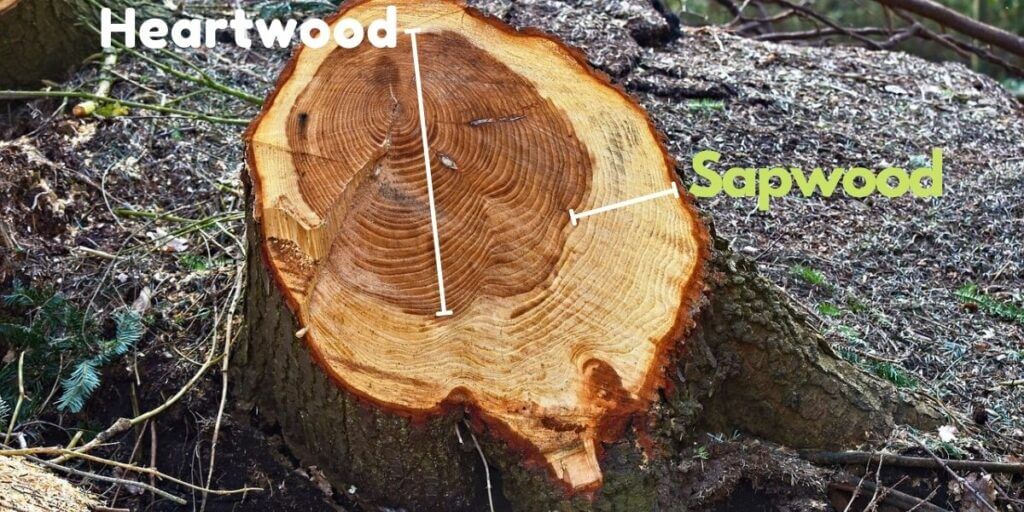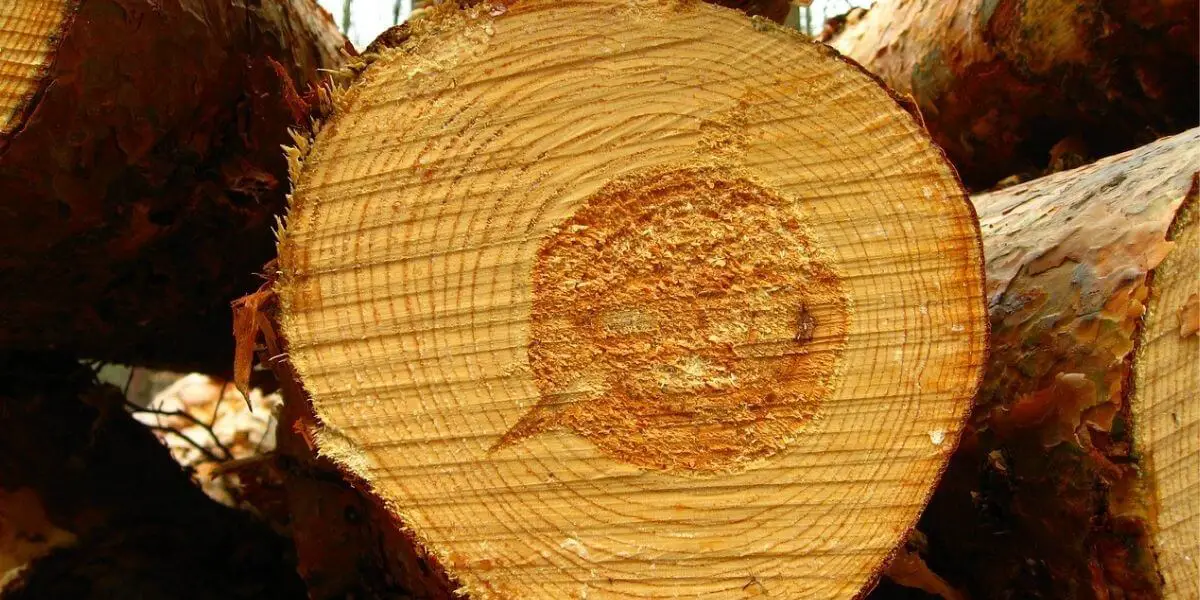Heartwood and Sapwood are the same portions of a tree. It is two parts of the same tree. Heartwood, also called Duramen, is the central core of the tree trunk.
On the other hand, Sapwood is the outer part of a tree’s trunk. It transports water and minerals to the tree’s leaves and branches, which is an essential contributor to tree growth.
Heartwood is more durable, stable, and rot-resistant than Sapwood. Their color, Heartwood, can distinguish Sapwood from Heartwood. The color of heartwooHeartwoodys darker than the Sapwood of a single tree. Meanwhile, the color of Sapwood is always lighter than that of Heartwood. The color of Sapwood and Heartwood may vary depending on the species of wood.
In other words, the Heartwood is a dead portion of the middle part of the tree, and Sapwood is the living outermost portion of the wood.
Heartwood and Sapwood Diagram

| # | Heartwood | Sapwood |
| Color | Darker Colored | Lighter colored |
| Weight | Due to its high density, it Weighs more than sapwood. | It is lighter than heartwood |
| Durability | It is more durable than sapwood. | It is not as durable as heartwood. |
| Contains Moisture | Moisture in heartwood is rarely present | It contains more moisture |
| Hardness | Its hardness is great. | It’s not as hard as heartwood |
| Availability and market demand | Heartwood is more involved in the wood industry | It also has demand but not as much as heartwood |
Uses : Heartwood vs Sapwood
Heartwood and sapwood are both parts of the same tree, but they are used differently based on their properties.
Heartwood Uses
As mentioned above, heartwood is more durable and stable than sapwood. Heartwood is used to make furniture, flooring, roofing, and many other wood applications. Most of the furniture you see is made from heartwood. Woodworkers use heartwood to create strong, durable, and good-looking applications.
Sapwood Uses
Sapwood is not as strong, rich, or beautiful as heartwood. It is the secondary wood of trees. Therefore, woodworkers prefer to use heartwood for the furniture. Sapwood is used for a small part of the furniture, or It is used in combination with heartwood.
It is the best wood for beginners to practice carving and cutting or a wood project that requires a two-tone pattern color. However, woodworkers rarely use sapwood because it is susceptible and more prone to rot and insect attacks. That’s why woodworkers don’t use sapwood.
Working with Heartwood and Sapwood
Working with heartwood or sapwood depends on the hardness of the different species of wood; however, sapwood has a lower density, so sapwood is easier to work with than heartwood.
Working with Heartwood
The heartwood of most species is easy to work with by hand and machine tools. However, some species are very hard and dense, while others have irregular or interconnected grains, which can be difficult to work with.
The working experience of heartwood depends on the species of wood. These are some wood species that are extremely hard and heavy, like Ebony, Brazilian Walnut, Black Ironwood and many others. These species are challenging for woodworkers to work with.
But there are several species whose heartwood is very easy to work with, easy to turn and easy to finish very well. Woods that are easy to work with are cedar, pine, redwood, Douglas fir, Western white pine, cherry and many others.
Working with Sapwood
Sapwood is much easier to work with than heartwood, as it is not as hard as heartwood. However, sapwood is used by beginners for the practice of woodworking because it is very cheap and easily available.
Strength : Heartwood vs Sapwood
Heartwood Strength
Heartwood is more durable and stable than sapwood. Therefore, it is best for structural purposes where the wood needs to handle heavy loads. Because of its good strength, this heartwood is a great choice for beams, floors, fences, roofs, decks and other outdoor projects.
Sapwood Strength
Sapwood does not have good strength; it is weaker than heartwood. It cannot be used for structural projects and starts to split and crack under high pressure.
Heartwood vs Sapwood Color
Heartwood Color
Most of the color of Heartwood is rich brown to dark chocolate brown. It depends on the wood species. The heartwood color of some species, such as mahogany, cherry, and Sapele wood, darkens over time.
When sapwood turns into Heartwood as trees grow, it stops delivering water, nutrients, and minerals to the trees’ leaves. The heartwood cells die and begin to dry out, causing their color to darken.
Sapwood Color
Most sapwood is white to pale yellow. But mostly, it is very close to pure white. Sapwood gets its color due to high moisture content and open cells.
Heartwood Pros and Cons
Pros
- Heartwood is rot-resistant and moisture resistant, therefore it requires low maintenance.
- Heartwood is strong and durable.
- Richer and often more desirable color compared to sapwood.
- Typically denser and harder than sapwood.
- Greater stability, with reduced susceptibility to warping and splitting.
Cons
- Harder to work with due to increased density.
- Limited availability in some wood species.
- May be more expensive than sapwood.
- Can have a higher risk of checking and cracking.
- Color may darken over time, affecting appearance.
Sapwood Pros and Cons
Pros
- It is very light and soft so it is easy to work with.
- Generally lighter in color and more uniform appearance.
- Often more readily available and less expensive.
- Can exhibit greater flexibility.
- May have a lower risk of checking and splitting.
Cons
- Sapwood contains a lot of moisture which causes the wood to bend or crack after drying.
- It cannot withstand moisture for a long time. It starts smelling and starts rotting within a month when exposed to moisture.
- Color may lack the richness of heartwood.
Walnut Sapwood vs Heartwood
Walnut Heartwood
The color of Walnut Heartwood is brown to dark brown. The color can be gray, purple, or red depending on the species of walnut.
The heartwood part of the walnut is broad. This means that the walnut contains a high amount of heartwood. The grain is usually straight but may be irregular. It is formed irregularly during the growth of the tree.
Walnut Sapwood
The sapwood of the walnut is not very wide. Walnut trees of some larger size do not have sapwood. Well, Walnut sapwood is nearly white. But it depends on the other species of nut. The sapwood of some walnut species can range in color from grey to dark yellow.
Cherry Heartwood vs Sapwood
Cherry Heartwood
The heartwood of cherry wood ranges from dark red to reddish-brown. Its color depends on the species and place of origin. Its color becomes darker with time when exposed to sunlight. The grain of cherry wood is uniform and straight.
Cherry Sapwood
The sapwood is light yellow to almost white. Cherry trees contain a large amount of sapwood. It also darkens with time but never as much as the heartwood.
Cedar Heartwood vs Sapwood
Cedar Heartwood
Generally, cedar heartwood is red to pinkish-reddish-brown with random brown stripes. Although color depends on the species, some species are very similar to each other, which is difficult to identify by color. A 10–15 year old cedar tree has heartwood about 7–8 cm in diameter.
Cedar Sapwood
Sapwood is pale yellowish-white to whitish-cream. The color of the sapwood also varies with the age of the cedar tree. A 10–15-year-old cedar tree has approximately 3-4 cm diameter sapwood.
Is Heartwood Stronger Than Sapwood?
Yes, there is no doubt that heartwood is stronger and more durable than sapwood. This is due to the accumulation of natural resins, extractives, and deposits over time, which contribute to increased hardness and resistance to decay.
Heartwood has greater resistance to insects and decay than sapwood. The natural compounds present in it act as a deterrent against wood-boring insects and microbial damage.
Does Heartwood Conduct Water?
No. Heartwood does not conduct water in the tree. Because the tree requires less water and the sapwood conducts water. Heartwood contains low moisture, which decreases with time. The heartwood of a green tree contains a lot of moisture.
The Conclusion
You can use sapwood along with heartwood for home furniture and indoor applications, but for outdoor applications, wood experts suggest that we always use heartwood.

